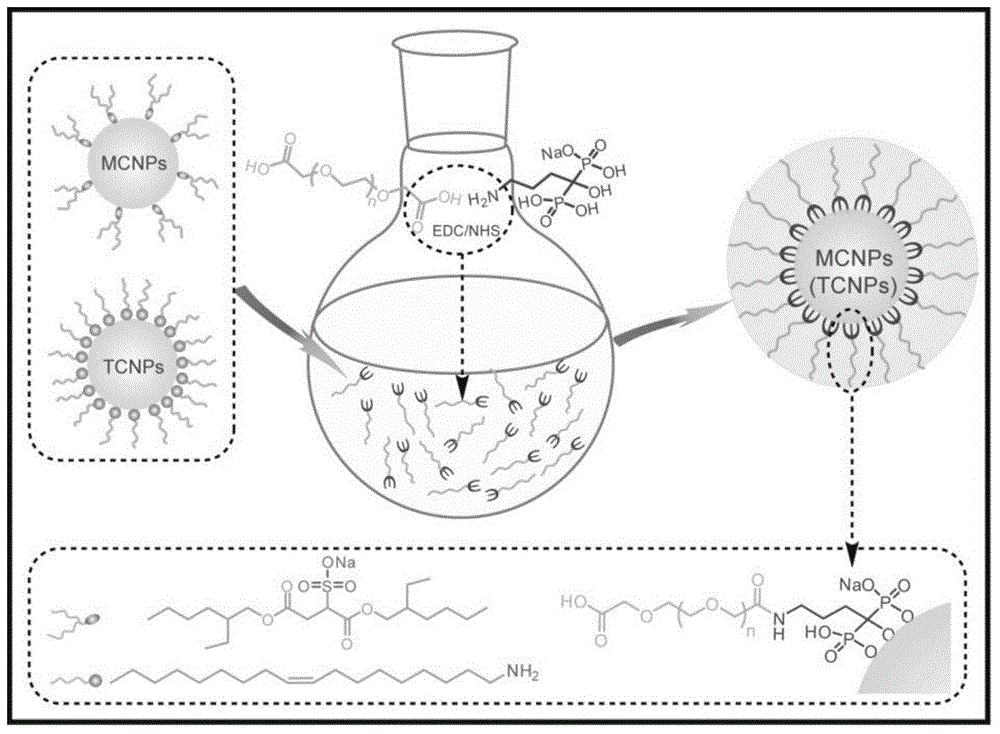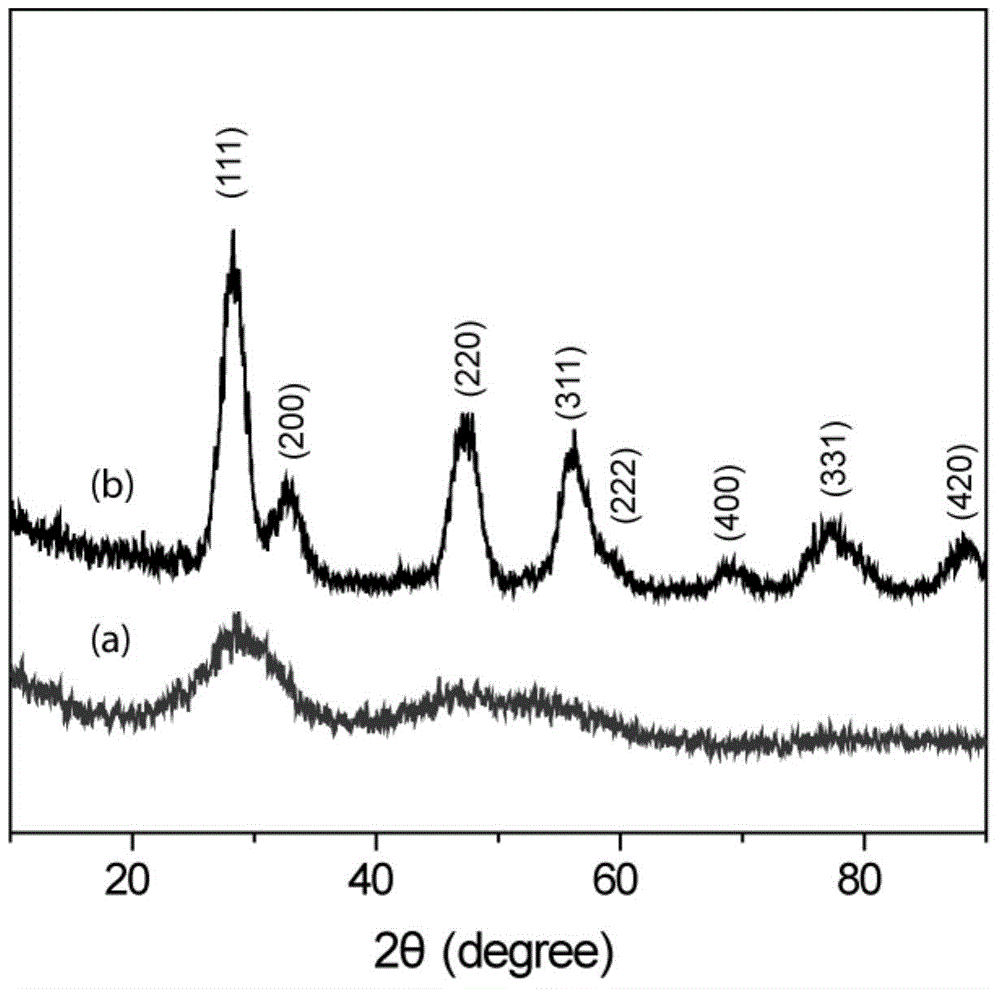Surface modification method for cerium nano-particles
A nanoparticle and surface modification technology, which is applied in the field of biomedical chemistry, can solve the problems of difficult functional molecule connection, toxic and side effects, and uncertain effectiveness, so as to achieve the reduction of non-specific interaction, the reduction of macrophage phagocytosis, and significant technical progressive effect
- Summary
- Abstract
- Description
- Claims
- Application Information
AI Technical Summary
Problems solved by technology
Method used
Image
Examples
Embodiment 1
[0036] Embodiment 1MCNPs-BP-PEG 600 Synthesis of (wherein BP is alendronate sodium, PEG 600 PEG dicarboxylic acid with a molecular weight of 600)
[0037] (1) Synthesis of MCNPs: Dissolve 0.75g AOT in 50mL toluene and add 2.5mL cerium nitrate with a concentration of 0.1mol / L. After stirring for 45min, add hydrogen peroxide (30%) dropwise at a speed of 5r / min with a peristaltic pump. The above solution was reacted at room temperature for 45 minutes and left to stand overnight to obtain MCNPs dispersed in toluene with a diameter of 3-5 nm;
[0038] (2) BP-PEG 600 Synthesis: 147mg PEG dicarboxylic acid, 30mg EDC·HCl and 15mg NHS were dissolved in 2mL of dichloromethane, reacted at room temperature for 6h and then the dichloromethane was removed by rotary evaporation; 20mg of alendronate sodium trihydrate and 50mg of carbonic acid Sodium was dissolved in 4 mL of deionized water and added to the above product, and reacted at room temperature for 12 hours to obtain the nanopartic...
Embodiment 2
[0049] Embodiment 2TCNPs-BP-PEG 600 Preparation (wherein BP is alendronate sodium, PEG 600 PEG dicarboxylic acid with a molecular weight of 600)
[0050] (1) Dissolve 0.434g of cerium nitrate in 0.802g of oleylamine (70%) and 4.0g of 1-octadecene (90%), stir and mix well and raise the temperature to 80°C within 3min, and react for 30min under the protection of argon. Under the condition of condensing reflux and argon gas, heat up to 260°C within 8 minutes and react for 2 hours. After cooling to room temperature, add acetone-absolute ethanol mixed solution (80mL), centrifuge the precipitate, wash it with the same solution several times, and finally disperse it TCNPs with a diameter of 3-5nm were obtained in alkane, which were precipitated with acetone and dispersed in tetrahydrofuran for ligand exchange reaction;
[0051] (2) BP-PEG 600 Synthesis: 147mg PEG dicarboxylic acid, 30mg EDC·HCl and 15mg NHS were dissolved in 2mL of dichloromethane, reacted at room temperature for ...
Embodiment 3
[0055] Embodiment 3MCNPs-BP-PEG 2000 Synthesis of (wherein BP is alendronate sodium, PEG 2000 PEG dicarboxylic acid with a molecular weight of 2000)
[0056] (1) Synthesis of MCNPs: Dissolve 0.75g AOT in 50mL toluene and add 2.5mL cerium nitrate with a concentration of 0.1mol / L. After stirring for 45min, add hydrogen peroxide (30%) dropwise at a speed of 5r / min with a peristaltic pump. The above solution was reacted at room temperature for 45 minutes and left to stand overnight to obtain MCNPs dispersed in toluene with a diameter of 3-5 nm;
[0057] (2) BP-PEG 2000 Synthesis: 392mg PEG dicarboxylic acid, 40mg EDC·HCl and 20mg NHS were dissolved in 4mL of dichloromethane, reacted at room temperature for 8h and then the dichloromethane was removed by rotary evaporation; 40mg of alendronate sodium trihydrate and 50mg of carbonic acid Sodium was dissolved in 4 mL of deionized water and added to the above product, and reacted at room temperature for 24 hours to obtain the nanopa...
PUM
| Property | Measurement | Unit |
|---|---|---|
| particle diameter | aaaaa | aaaaa |
| diameter | aaaaa | aaaaa |
Abstract
Description
Claims
Application Information
 Login to View More
Login to View More - R&D
- Intellectual Property
- Life Sciences
- Materials
- Tech Scout
- Unparalleled Data Quality
- Higher Quality Content
- 60% Fewer Hallucinations
Browse by: Latest US Patents, China's latest patents, Technical Efficacy Thesaurus, Application Domain, Technology Topic, Popular Technical Reports.
© 2025 PatSnap. All rights reserved.Legal|Privacy policy|Modern Slavery Act Transparency Statement|Sitemap|About US| Contact US: help@patsnap.com



